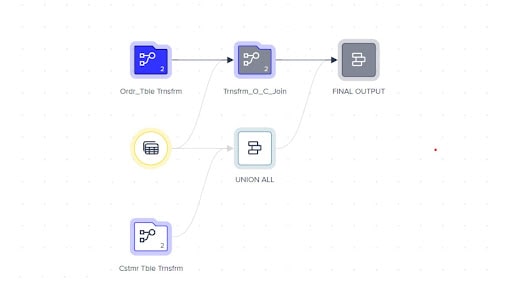A How-To Guide for Unlocking Complex SQL in Datameer
- Jeffrey Agadumo
- May 26, 2023

This comprehensive guide will show you how to write complex SQL queries in Datameer and explore more visual alternatives.
SQL – Structured Query Language is the backbone of data management and analysis, and complex SQL queries play a crucial role in unlocking the full potential of your data.
Whether you’re working with big data or small, the ability to write and execute complex SQL queries can significantly enhance your analysis capabilities and provide you with more accurate and valuable insights.
Whether you’re new to SQL or an experienced user, this guide will provide you with helpful knowledge and practical skills to take your data analysis to the next level and unlock the full potential of your data in Datameer.
If you’re ready to up your SQL game and leverage the full power of Datameer to become a data pro, keep reading!
How to Write Complex SQL
SQL (Structured Query Language) is the standard language for managing and manipulating relational databases. It’s a powerful tool that allows you to extract, analyze, and transform data stored in databases.
However, you may need more advanced SQL techniques to effectively work with your data when dealing with large data sets, and this is where complex SQL comes in.
Complex SQL queries go beyond the basics of SELECT, FROM, and WHERE statements and incorporate advanced techniques and more complex syntax to query and manipulate data. This complex syntax allows you to analyze complex data, generate sophisticated reports, and answer challenging business questions.
So, what exactly makes a SQL query complex? Here are some of the key elements of an SQL query:
- Join Operation: This SQL command combines data from multiple tables in a relational database, allowing you to create a more complete picture of your data.
- Subqueries: These are nested SELECT statements within a larger query. They allow you to execute multiple queries within one query and can be used to generate more complex reports and perform more advanced data analysis.
- Aggregation Functions: Aggregation functions allow you to perform mathematical operations on data sets, such as calculating the sum, average, or count of values. These functions are often combined with GROUP BY clauses for more complex data analysis.
- Window Functions: Window functions perform calculations over a set of rows within a query result. They allow you to calculate rankings, percentiles, and other measurements based on specific data within a result set.
Datameer is a powerful big data analytics platform that enables you to quickly and efficiently process and analyze large amounts of data. But to truly unlock its full potential, you need to be able to perform complex SQL queries on large data sets.
How to Perform Complex SQL in Datameer
The Datameer workbench offers two methods for querying data with SQL. The first is through an SQL editor designed for professionals and enthusiasts comfortable writing code. The second option is a no-code suite of user-friendly, point-and-click tools that allow you to execute SQL queries without coding skills.
The no-code feature in Datameer is very helpful for querying data quickly and effortlessly. However, it only occasionally offers the full functionality needed for complex queries. Therefore, supplementing the no-code feature with code written in the SQL editor is often necessary for a more comprehensive data analysis process.
By combining the two approaches, users can optimize the querying process and obtain a more detailed understanding of their data, even for complex queries.
This article section focuses on the options for querying data without requiring coding skills. We’ll discuss no-code alternatives that can execute complex queries, building upon the elements mentioned earlier in the article.
1. Subqueries
In Datameer, you must write subqueries using standard SQL code within the platform’s SQL editor because there isn’t any no-code alternative. However, these subqueries are essential for handling complex data querying tasks that SQL is known for; hence they are included in this list.
2. Joins
The join interface allows you to select the data sources and offers inner joins, left outer joins, right outer joins, and full outer joins, simplifying the joining process. You can also select specific conditions, such as matching values in key columns, to join datasets.
3. Aggregate Functions
In Datameer, you can utilize aggregate functions like sum, count, average, maximum, minimum, and more by selecting your dataset, navigating to the aggregate option, and selecting the desired column or group of columns. Additionally, you can choose a specific column as the field for grouping the data using the GROUP BY clause.
4. Window Functions
You can find Window functions in Datameer within the SQL editor by selecting the windowing option to the workbench’s right. This enables you to incorporate functions such as RANK(), NTILE(), LEAD(), and more into their SQL queries, showcasing an effective combination of code and no-code approaches.
Datameer For Everyone!
Datameer is perfect for all users, from data experts to business professionals. Its powerful features and user-friendly interface simplifies the data analysis and management process.
Data engineers and scientists can also use advanced data integration, preparation, and analytics capabilities to easily derive insights and make data-driven decisions.
For business users, Datameer’s intuitive, spreadsheet-like design simplifies data manipulation without the need for coding expertise. Users can quickly create visualizations and interactive dashboards to share with stakeholders, fostering collaboration and informed decision-making.
In summary, Datameer’s accessible design and diverse features encourage teamwork and data-driven success across user profiles.
Now that you know that Datameer has a little something for everyone, you should be asking what it can do for you.



